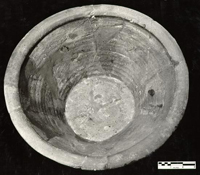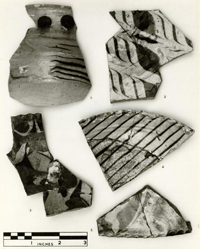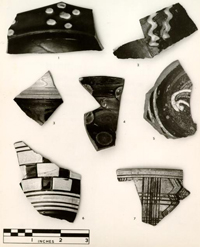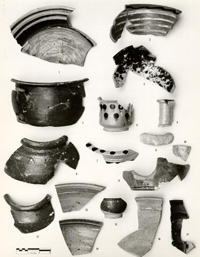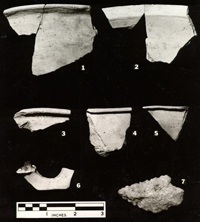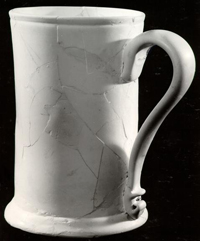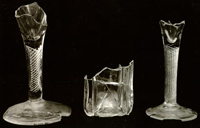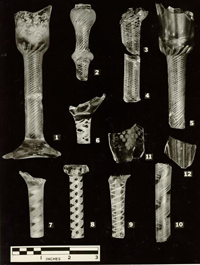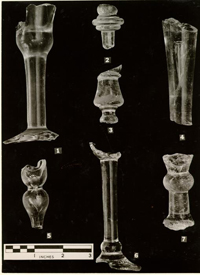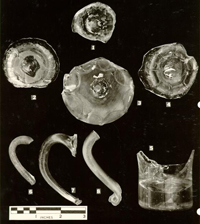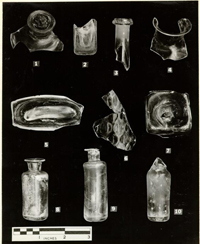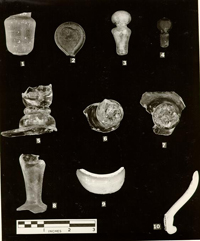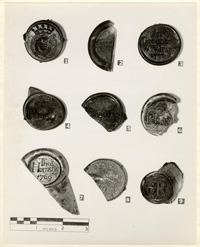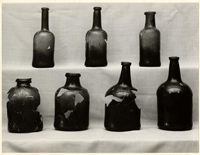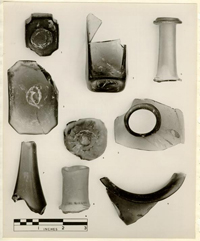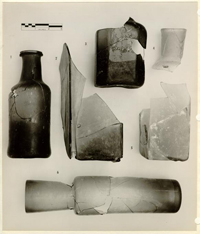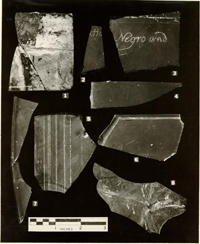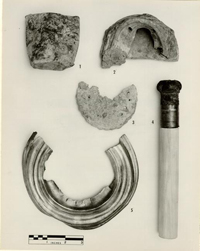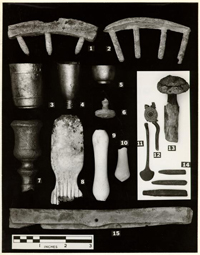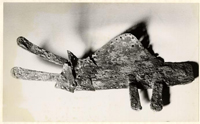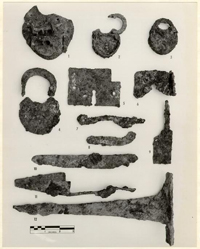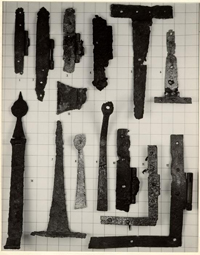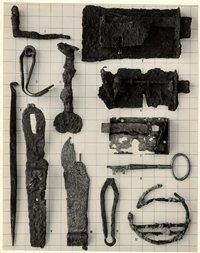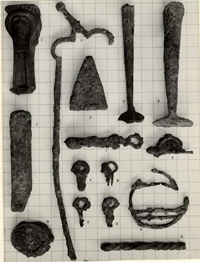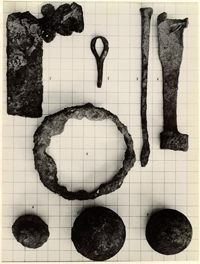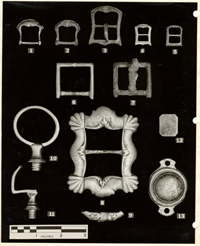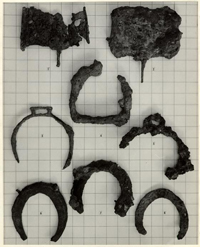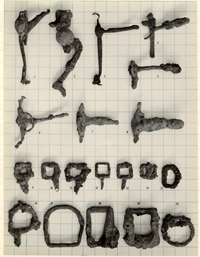Anthony House (NB) Archaeological Report Vol III Part II, Block 28 Building 71 Lot 263 & 264Originally entitled: "The Anthony Hay Site Block 28, Area D, Colonial Lots 263 and 264 Report on Archaeological Excavations of 1959-1960, The Artifacts, Volume III Part II"
Colonial Williamsburg Foundation Library Research Report Series - 1555
Colonial Williamsburg Foundation Library
Williamsburg, Virginia
1990
THE ANTHONY HAY SITE
Block 28, Area D
Colonial Lots 263 and 264REPORT ON ARCHAEOLOGICAL EXCAVATIONS OF 1959-1960
THE ARTIFACTS
Volume III
Part II
TABLE OF CONTENTS
| Part 1 | |
| Table of figures | |
| Bibliographic abbreviations | |
| Introduction | |
| Figures 1 to 35 | |
| Part 2 | |
| Figures 36 to 64 | |
| Dating of Excavation Register Groups | |
| List of photograph negative numbers | |
Figure 36
West of England earthernware creampan with ginger-brown glaze on the inside, the rim flattened and slightly overhanging the interior wall; the ware pink and heavily gravel-tempered. E.R. 192, 205, 229, 230D, 234, 243C, F, G, K, M and N.
Figure 37
- 1.Fragments of large posset cup of English yellow ware, Staffordshire or Bristol, the body bulbous and the rim everted, brown slip dots on the neck and combing on the body, the handle (not shown) small, strapped and typical of the form. E.R.243B.
- 2.Body fragments from bat-molded dish, a pale pink body with flecks of ochre, overall red slip with white over it and feathered, probably Staffordshire. E.R. 191, 233.
- 3.Section through bat-molded circular dish, the body a laminated yellow flecked with ochre, coated with white slip and then marbleized with additional dark and light brown slips, the rim pie-crust notched; presumably Staffordshire. E.R.237J.
- 4.Section through small, circular bat-molded dish, the rim notched, laminated pink and white clays flecked with ochre, white slipped and combed with thin stripes of red, creating a yellow and brown combination when glazed; probably Staffordshire. E.R.198, 204.
- 5.Rim sherd from large bat-molded dish, notched edge, the body red with haphazardly applied red and white slips, the latter splashed with copper, creating when glazed a brown, yellow and green combination. Probably Pennsylvania. E.R.205.
Figure 38
- 1.Rim sherd of small, octagonal (?) bat-molded dish, a hard pink body, highly fired, coated with a lustrous black glaze, the rim ornamented with groups of yellow slip dots. E.R.237M.
- 2.Body fragment from larger bulbous pitcher or chamber-pot, cream-colored body, yellow glaze internally, and dramatic black glaze outside ornamented with trailed white slip. E.R.237M.
- 3.Shoulder fragment from chamberpot of the same character as the above, but of considerably better quality, yellow-glazed internally, yellow at the neck externally, and black on the body. Other sherds indicate that the body was ornamented with trailed yellow slip in the manner of No. 2. See also Fig. 39, No. 7. for a rim section of a similar (if not the same) chamberpot, showing the use of black dots on the yellow rim contrasting with the yellow slip against the black of the body. These fragments represent the first chamberpots of their kind found in Williamsburg to date. E.R.243C, 243L, 247D, 337A.
- 4.Section through small bat-molded dish with body similar to No. 1, coated with black to purple glaze (resulting as does No. 1, from the darkening effect of the red body on an amber glaze) and ornamented with yellow dots of slip. E.R.200, 252C, 337A, 337F.
- 5.Base of small red-bodied bowl ornamented on the interior wall with narrow bands of slip and on the base with a white slip scroll device, part of which is touched with copper; probably Pennsylvania. E.R.195.
- 6.Wall fragment of sgraffiato-decorated bowl, white slip cut away to expose the coarse agate body beneath. An example of this ware in the Burnap Collection (Burnap, No. 30) Is dated 1759. E.R.237J.
- 7.Bowl fragment of similar character to the above, but the pattern in Incised lines rather than cut squares, badly burned. E.R.221, 257A.
Figure 39
- 1.Coarse agate ware bowl, Staffordshire or perhaps Newcastle-under-Lyme, three bands of rouletted white slip on rim, over-all amber glaze resulting in brown agate body with yellow bands. E.R.237F, 237J.
- 2.Slipware bowl, red body with yellow bands of slip internally and black wavy band on rim, probably Pennsylvania. (See also Fig. 38, No. 5 for comparable base). E.R.217, 228.
- 3.Hemispherical bowl (interior view), small solid base, the body wall tapering to a straight vertical lip, red body with interior white slip splashed with manganese and coated with an amber glaze, giving brown exterior. Comparable to two bowls found at the Public Gaol. Probably Pennsylvania. E.R.243K, 248, 369H.
- 4.Chamberpot, brown-glazed red ware, with everted and folded rim decorated with a single trail of white slip at the edge, slight cordoning at the shoulder, the handle strapped. Possibly Samuel Bell of New-castle-under-Lyme, E.R.192, 209, 23OC, 243C.
- 5.Slipware cup, yellow ware with two rows of brown dots on the body, vestigial pedestal base, the rim slightly everted, handle missing. Bristol or Staffordshire. E.R.337A.
- 6.Candle holder, yellow ware, with brown dots on the flattened rim, traces of strapped handle. (See also comparable drip-tray sherd from Hay well, E.R.361B). E.R.237J.
- 7.Rim fragment from yellow ware chamberpot, the rim flattened and ornamented with brown dots, cordon at shoulder and the body beneath it coated with brown to black slip (i.e. red slip under amber glaze). See also Fig. 38, Nos. 2 & 3 for body sherds. E.R.195, 243.
- 8.Shoulder and folded bead rim from red ware jar, brown glazed, exterior only. Ornamental groove on shoulder. E.R.209, 228, 230C, 230F, and possibly 369G.
- 9.Rim sherd, folded, from coarse earthenware oil jar, with internal green glaze, probably Spanish. E.R.227A.
- 10.Spout sherd, probably from pitcher, red ware coated with white slip and then apple-green glazed. E.R.337.
- 11.Base and body fragments from jar or pitcher, ware and glaze as above, but yellow interior, perhaps Spanish. E.R.243A, 246.
- 12.Shoulder and folded bead rim from redware jar, ginger brown glaze on exterior running down internally, groove on shoulder. Form as No. 8. but smaller. E.R.364B.
- 13.Rim and body fragment from shallow pan, red body with ginger brown glaze, the rim offset and rolled upwards, unglazed exterior. E.R.247F.
- 14.Rim and body fragment of cream pan, yellow ware flecked with ochre, the rim beaded on the exterior and curving inwards and overhanging the interior of the bowl, brown glaze. Yorktown manufacture. E.R.337D.
- 15.Ointment pot in delft form but with everted and down-turned rim in the manner of white saltglaze, the body incurving above a flat base, hard yellow ware coated with an amber to brown glaze, rim diameter approximately three inches. Staffordshire or Bristol. E.R.243M.
- 16.Section through pan with hammer-head rim in style of No. 13, yellow to pink body flecked with ochre, probably of Yorktown manufactures decayed yellow glaze on the interior, the ware fired rather higher than usual. E.R.233.
- 17.Section through shallow plate of small size, diameter approximately eight inches, red body with deep reddish-brown glaze. Pennsylvania or New England. E.R.246.
Figure 40
- 1Bowl, rim and wall fragments only, Colono-Indian pottery, the body buff and thickly flocked with red ochre; no shell temper; rim everted and up-bent. E.R. 192, 247G.
- 2Bowl, Colono-Indian pottery, form as above, pronounced pebble or stick burnishing on the exterior, body with somewhat less ochre than No. 1. E.R.192.
- 3Pan, rim sherd only, Colono-Indian pottery, buff body shell tempered, rim flattened. E.R.233.
- 4Vertical walled bowl, Colono-Indian pottery, small everted and down-bent rim, the body buff to pink, flecked with red ochre and tempered with shell. E.R.244B.
- 5Bowl, Colono-Indian pottery, with flattened and everted rim, the body buff, slightly flocked with red ochre, and stick burnished. E.R.247C.
- 6Porringer handle, Colono-Indian pottery, buff body with no temper. E.R.200.
- 7Projectile point, large size, red quartzite, tanged and with blade serrated. Late Woodland period (?) E.R.341B.
Figure 41
- 1.Opaque white glass tankard in English white salt-glaze style, the body slightly concave in the mid-section, the rim thickened, slightly everted and grooved below the lip; the base thickened with an applied trail tooled into a gently stepped footring, the base raised within and with central pontil mark. The handle is a typically "glass" creation, thick and flattened where attached against the lower wall, drawn out into a pad reminiscent of the thumb pad so often seen on the shoulders of bottle decanter handles; the handle terminal finally drawn out and turned-back on itself. The metal is a dense white and shows no indication of ever having been enamelled or gilded. The tankard stands six and one-sixteenth inches in height, has a top diameter of three and thirteen-sixteenths inches, and a base diameter of four and one-eighth inches.
This is one of the most important items of glass yet encountered in Williamsburg excavations and is perhaps a decade earlier than its context suggests. E.R.230D, 243K, 247D, 369G.
Figure 42
- 1.Goblet, air twist stem, trumpet bowl and plain conical foot with rough pontil mark. Surviving height, six and one-quarter inches; foot diameter, three and seven-eighths inches. c.1740-1770. E.R.247G.
- 2.Base of mallet-shaped decanter, a restrained form of the pronounced quatrefoil shape of the second quarter of the 18th century; rough pontil mark on the conical basal kick. E.R.192, 195, 206, 228, 243M, 247G, 247F.
- 3.Wine glass, air twist stem, trumpet bowl and plain conical foot with pontil mark. C.1740-1770. E.R.247G.
Figure 43
- 1.Wine glass, straight air twist stem, heavy clear metal, waisted bowl, conical foot with large pontil mark; a two-piece glass. c.1740-1770. E.R.233.
- 2.Air twist stem with central knop and another larger knop at the top, both created from the stem itself; a collar has been added at the junction of stem and bowl. A mid-18th century form. Haynes, P1. 52a. E.R.229.
- 3-4.Two fragments of a straight air twist stem, the channels very fine and the metal clear and with a high sparkle, a combination of qualities superior to the foregoing examples. c.1740-1770. E.R.244B, 200.
- 5.Wine glass with air twist stem, similar to No. 1. E.R.247G.
- 6.Wine glass fragment with opaque white twist stem, a spiral gauze and a widely spaced 2-ply spiral band. c.1750-1780. E.R.229.
- 7.Stem fragment and base of bowl, the former decorated with an opaque white corkscrew with a single 9-ply spiral band. C.1750-1780. E.R.23TB.
- 8.Stem with fragment of base attached, opaque white twist in the form of a pair of spiral gauzes. C.1750-1780. E.R.231C.
- 9.Stem with opaque white twist, straight gauze with widely spaced 2-ply spiral. c.1750-1780. E.R.237A.
- 10.Stem, air twist, central wide spiral core with single 10-ply spiral band. c.1740-1770. E.R.230C.
- 11.Wine glass, ogee bowl fragment, engraved with botryoid device, probably Newcastle. c.1760-1770. E.R.200.
- 12.Fragment of rib-molded tumbler or flip glass, soda metal; of same type as Fig. 45, No. 2. Probably of American manufacture. E.R.228.
Figure 44
- 1.Wine glass, waisted bowl and heavy base with single small tear, straight solid stem and plain conical foot, a two-piece glass. c.1740-1760. E.R.243W.
- 2.Stem fragment from wine or ale glass with annulated triple-band knop below a flattened knop. c.1725-1735. E.R.243N.
- 3.Stem fragment with a truncated cone containing a single tear as the central feature, resting on a small dumbbell-shaped knop. There is a collar at the junction of cone and bowl (or another larger knop); the lead metal pale straw in color. c.1710. E.R.337F.
- 4.Goblet stem of large proportions, solid with a single massive tear, the bowl probably trumpet-shaped, a two-piece glass. c.1740-1760. E.R.247G.
- 5.Stem and bowl fragment from small glass of unusual type, small waisted bowl with solid base, inverted baluster stem, a single tear extending from the bowl base into the baluster, the metal a blue-grey in reflected light. Presumably a two-piece glass. E.R.233.
- 6.Wine glass with straight solid stem, probably with ogee bowl, knop at the junction of stem and conical foot. The metal is brilliant and of good quality. c.1740-1760. E.R.230C.
- 7.Stem, short, solid, balustroid, single knop; the metal heavy and the craftsmanship of low quality. E.R.192A.
Figure 45
- 1.Base of small tumbler with rough pontil mark over diamond-shaped moldings clear metal, uncertain height. E.R.192.
- 2.Base of flaring tumbler or flip glass, molded ribbing on the body, banal pontil mark partially ground, light clear metal, almost certainly of American manufacture. See Fig. 43, No. 12. C. F. McKearin, P1. 29, No. 6. E.R.230C.
- 3.Base of large tumbler or flask, the body apparently sloping inwards above the base, elaborate basal molding presumably extending into raised vertical ribs on the body, the metal somewhat clouded, perhaps through soil action, rough pontil mark. E.R.237N.
- 4.Base of flaring sweetmeat dish (?), the base with molded octagon and raised ribs radiating from it and continuing up onto the wall, the soda metal thin and clear with a slight purple cast probably occasioned by surface decay; possibly American manufacture. E.R.231C.
- 5.Base of thick-bottomed and waisted tumbler, small pontil mark, and clear metal, a form generally attributed to the 1770's. Hughes, p. 349, No. 275. E.R.229.
- 6.Handles possibly from posset cup, pale straw cast to the metal. E.R.243.
- 7.Handle, possibly from sugar bowl, thin and clear soda metal, the body ornamented with thread trail. Almost certainly of American manufacture. C. f. McKearin, P1. 28, No. 3. E.R.309.
- 8.Handles heavy lead metal, probably from bottle decanter, the terminal turned back on itself and pinched into a vestigial pad. E.R.243S.
Figure 46
- 1.Neck and shoulder of pharmaceutical bottle, the metal thin and pale straw in color; the shoulder angular, the lip everted over a short cylindrical neck. The cork is still in position. This bottle was thought to be soda glass, but was tested and found to contain lead. E.R.243W.
- 2.Base of small, square-molded perfume bottle, heavy and clear lead glass, the thickening wall near the base causing an internal tapering towards the bottom. E.R.243N.
- 3.Neck of small pharmaceutical bottle, clear metal, but otherwise similar to the blue-green example shown in Fig. 50, No. 6. E.R.231D.
- 4.Neck fragment of small wide-mouthed bottle, clear metal; a weak shoulder and a small rim everted over a short cylindrical neck. The lightness of the metal perhaps suggests an American origin for the bottle. E.R.193.
- 5.Base of oval-bodied flask or bottle with a long basal kick having the appearance of being pushed up with a spatula-shaped tool. E.R.256A.
- 6.Wall fragments of beaker with molded lozenge ornament, clear lead metal. This form of decoration was popular among German glassmakers of the seventeenth century and consequently among emigrant glassmakers in eighteenth century America. A similar fragment was found beneath the S. E. pier of the Hay shop and that was tentatively identified by the Victoria & Albert Museum as being of American origin. E.R.293.
- 7.Base of square-bodied bottle, thin-walled clear metal, with a finely pitted wall surface derived from contact with the mold. Perhaps American. E.R.230C.
- 8.Small pharmaceutical bottle, clear metal, small conical basal kick, flattened and everted rim over a short cylindrical neck above angular shoulder. E.R.198.
- 9.Pharmaceutical bottle, similar to the above, but somewhat taller. E.R.231C.
- 10.Pharmaceutical or perfume phial, clear lead metal; the base thick and with very slight kick, the body wider at the shoulder than at the base, and the neck somewhat flaring towards the top. E.R.230D.
Figure 47
- 1.Stopper, solid and clear lead metal, knob missing, rough pontil scar on base, evidence of wear at the shoulder. E.R.243J.
- 2.Pad knob from stopper, clear metal with surface tooling marks, a late form. E.R.191.
- 3.Stopper, blown from single bubble constructed above the shoulder, open at the bottom. E.R.191.
- 4.Stopper, solid emerald green metal, the knob flat and faceted, the stopper itself ground; probably from a perfume bottle. E.R.192.
- 5.Syllabub or jolly glass base, clear metal, domed foot with rough pontil mark, flattened knop with twisted bubbles in lieu of stem, bowl with solid base. E.R.228.
- 6.As above, though smaller, the knop larger and the foot less markedly domed. E.R.231C.
- 7.As No. 6. E.R.226.
- 8.Wine glass stem, solid, with bowl made as one with the stem. This glass has suffered in a fire. E.R.300.
- 9.Fragment of opaque white glass ointment pot (?) with green exterior flashing, extremely crudely made, the base missing, but the interior depth no more than thirteen-sixteenths of an inch. E.R.274.
- 10.Handle from small mug, opaque white glass, the terminal roughly pressed against the wall of the vessel and then turned back on itself; thickness of mug wall one-sixteenth of an inch. E.R.243.
Figure 48
- 1.Bottle seal, Poulett arms. Gartered shield of arms under an earl's coronet, three swords in first and fourth quarters, millet in second and third, three battering rams on shield in pretence. Arms of first Earl Poulett, nominated a Knight of the Garter, 1712; d. 1743. E.R.191.
- 2.Bottle seal fragment, "Jn[o.] Gree[nhow] Wms.[burg] 17[70]". Greenhow was a Williamsburg merchant, b. 1724, do. 1787; his seals have been found all over the town, with more than eighty coming from the site of his store alone. E.R.254B.
- 3.Greenhow bottle for comparison with the fragment above. This example comes from the Greenhow store site on Duke of Gloucester Street.
- 4.Bottle seal marked "Prentis", William Prentis, Williamsburg merchant from c.1724, d. 1765. E.R.231C.
- 5.Bottle seal as above, but from different matrix. E.R.191.
- 6.Bottle seal, from same matrix as No. 5. E.R.363B.
- 7.Bottle seal, "Thos. Hornsby 1769"; Williamsburg merchant and tailor, d. 1772. E.R.362.
- 8.Bottle seal fragment, "I [Taze]well [1]768"; John Tazewell of Northampton County, Williamsburg lawyer from 1761, d. 1781. E.R.191.
- 9.Bottle seal with device of two "R"s back to back, from a French bottle of the 19th century. Unstratified, found in 1949 excavations.
Figure 49
Numbering top left to bottom right
- 1.Wine bottle of small size, olive green metal somewhat bubbled and with Surface pitted from contact with mold, the neck straight and with a down-tooled string-rim close to the lip; the shoulder pronounced, the base thick and with a domed kick. An unusual form. Height, eight and one-half inches. c.1760-177O. E.R.254C.
- 2.Wine bottle of small size, olive green metal with pitted surface on the body resulting from contact with the mold, the mouth slightly everted over a down-tooled string-rim, the neck somewhat pinched beneath, the base thick and with a pronounced domed kick. An unusual form. c.1760-1770. Height, eight and five-sixteenths inches. E.R.254C.
- 3.Bottle of unusual form, the metal a rich green and much bubbled, the neck short and the mouth everted over a roughly trailed string-rim a shallow domed basal kick with no pontil mark. Possibly of American manufacture. Height, seven and five-eighths inches. The same bottle also appears In Fig. 51, No. 1. E.R.254C.
- 4.Cylindrical jar, body similar to that of bottle No. 6, but the neck short and thickened with an applied trail at the lip and down-tooled; the base thick and with a shallow, domed kick, the metal olive green and somewhat bubbled. Height, six and three-quarters inches. The first of its type to be found in Williamsburg. E.R.254C.
- 5.Jar as above, but with the neck slightly taller and the mouth everted over the marvered thickening trail. Height, seven and one-half inches. E.R.254C.
- 6.Wine bottle with body comparable to that of the preceding jars, a short cylinder with domed basal kick and weak shoulders; the neck tapering and the mouth everted over a flat-sectioned trail; the metal olive green and much bubbled. Height, nine inches. E.R.254C.
- 7.Wine bottle of shape similar to the above, but somewhat taller in the body; the latter somewhat pitted from contact with the mold, the top of the mold clearly visible as a line over which the shoulder and upper body has spread. It is significant that the area above the mold line is both smooth and sleek. The neck is somewhat tapered and the mouth everted over a flat-sectioned trail that merges lip and string-rim into a single collar; the base domed; the metal olive to amber and somewhat bubbled. Height, nine and three-eighths inches. E.R.254C.
N.B. All the glass bottles and jars in this plate were found in the same deposit amid the later stream silt to the south of the Hay shop.
Figure 50
- 1.Base of small pharmaceutical or perfume bottle, emerald green metal, octagonally molded but with the corners fluted, possibly American manufacture. E.R.237A.
- 2.Basal fragments of square-bodied bottle, blue-green metal, possibly American manufacture. E.R.243K.
- 3.Base of octagonal bottle, blue-green metal, a snuff or blacking bottle; provenance probably as No. 1. E.R.200.
- 4.Base of small perfume bottle, molded pattern of raised diamonds on the base, blue-green metal. The base is slightly oval, indicating that the body was also somewhat flattened on the sides. It would appear that the basal diamonds turn to wrythen ribbing on the body. A neck fragment from a bottle of this type was found in a context of c.1763-1772 at Rosewell in Gloucester County, Virginia. Both neck and base fragments were found in a deposit of c.1740-1750 at the Coke-Garrett House in Williamsburg (E.R.140). The bottle is probably of American manufacture. E.R.236A.
- 5.Mouth and shoulder fragment of blacking or snuff bottle, square-bodied, pale olive green metal much bubbled, the everted mouth springing directly from the shoulder. This bottle is important in that it represents an early example of style of bottle extensively manufactured in American glass-houses in the first half of the nineteenth century. McKearin, P1. 227. E.R.243K.
- 6.Neck of pharmaceutical bottle of bulbous form in the style of wine bottles of the mid-seventeenth century, pale blue-green metal; the rim thickened and reinforced with a heavy, round-sectioned string-rim. E.R.230C.
- 7.Conical tubular fragment with an internal bore of a quarter-inch at the top and three-quarters of an inch at the lower fracture, emerald green metal, no bubbles but with vertical stress marks on the exterior; from an object of uncertain purpose and form. E.R.192.
- 8.Neck from square-bodied bottle, blue-green metal with a multitude of vertical scratch-like bubbles; the neck roughly cut from the blowing iron. A number of bottles of this type were represented among fragments from this site. (See Fig. 51, No. 4). It seems probable that such bottles are of American colonial manufacture. E.R.231D.
- 9.Rim fragment of pickle jar, olive green metal, the rim everted over the shoulder with no dividing neck, the body four-sided. An example was found at Rosewell in a context of 1763-1772 and another was found at Tutter's Neck in a context of c.1730-1740. E.R.198.
Figure 51
- 1.Bottle of unusual form, the metal a rich green and much bubbled, the neck short and the mouth everted over a roughly trailed string-rim, a shallow domed basal kick with no pontil mark. See also Fig 49, No. 3. Possibly of American manufacture. E.R.254C.
- 2.Base and lower body fragment of large and thin-walled case bottle, the metal olive green and one side somewhat corrugated, having sagged after removal from the mold; the base thick, slightly domed, and bearing a large pontil ring. E.R.243M.
- 3.Body of octagonal bottle, possibly with wine bottle neck or more probably with short neck and wide mouth typical of snuff or blacking bottles; the metal olive green, base thick and slightly raised. The front panel is engraved "Mr. Edmond..." and on the only surviving fragment of the back panel at the same level are the letters "...an". It is conceivable, though by no means certain, that this bottle may have borne the name of cabinet-maker Edmund Dickinson. Its presence in the first stream seems to belie such a construction. E.R.243W.
- 4-5.Neck and body fragments of square bottle, pale blue metal much bubbled, the neck slightly thickened at the lip, the base slightly rising. (See also Fig. 50, No. 8). Possibly of American manufacture. Fragments of a number of such bottles were found in the stream. The base fragment of this bottle came from the first stream bed (E.R.243W), but as the rest of the pieces came from higher up, it must be assumed that it had settled out of context. Neck E.R.247G; other fragments E.R.199, 243, and 243W.
- 6.Cylindrical bottle with wide, thick mouth; thick base with pronounced conical kick scarred with a rough pontil mark; the metal a pale amber and somewhat bubbled. The neck is similar in hue and shape to many associated with urinals. It is possible that this is one such vessel of unusual form. E.R.341A.
Figure 52
- 1.Fragment of mirror plate, one-quarter of an inch in thickness; intended fracture lines marked with a glazier's diamond along lower and upper edges. Various incomplete devices are roughly engraved on the upper side including part of a scroll and the letters "...ifs" (Miss?). On the back is engraved the name "Thos". The metal is a smoky blue-grey and appears to have been burnt. E.R.248.
- 2.Fragment of mirror plate, one-quarter of an inch in thickness, intended fracture line marked with diamond on the back of the lower edge, a fragmentary engraved inscription at the top, perhaps reading "Ha...". This fragment is part of the same plate and inscription as No. 3. The metal a smoky grey. E.R.200.
- 3.Fragment of mirror plate, one-quarter of an inch in thickness, intended fracture line marked with a diamond on the back of the lower edge, two others at the top of the back and a fourth on the upper surface at the top. A fragmentary engraved inscription reads "Negro and " See also No. 2. E.R.231D.
- 4.Mirror plate fragment, one-quarter of an inch in thickness, same smoky grey color as Nos. 2 & 3, the plate tapering in section at the left and ground on the edge. E.R.191.
- 5.Mirror plate fragment, one-quarter of an inch in thickness, ground on the left edge, and marked on both sides with vertical diamond scoring to aid in breaking; the metal a pale grey. E.R.243K.
- 6.Fragment of shaped mirror plate, an eighth of an inch in thickness, pale straw in color, the upper and left edges are ground and a deep ground line follows the outline as a decorative device on the upper surface. E.R.206.
- 7.Fragment of edge from a crown of glass, the metal a pale blue-green and the useful area approximately one-sixteenth of an inch in thickness. E.R.200.
- 8.Engraved fragment of plate glass, the metal pale grey, the left and right edges tapered and ground and polished; the central panel is engraved with a pheasant-like bird atop a floral sprig. E.R.274.
Figure 53
- 1.Small pewter canister of uncertain purpose, the rim roughly turned inwards, and an incised groove three-eighths of an inch above the base providing the only ornament. E.R.231D.
- 2.Part of a circular lead ink stand with a central hole in the top for a well, surrounded by five or perhaps six holes for pens (four holes only surviving). The stand was approximately two and one-half inches in height and had a base diameter of approximately four and one-eighth inches. The object shows clear indications on both base and side of having been spun, and the latter is ornamented with ridges above the base and below the top and with two medial grooves. A very small nail had been driven up through the center of the bottom from the outside, the purpose of which is uncertain. E.R.231C.
- 3.Lead disc one-eighth of an inch in thickness, the edge somewhat hammered and slashed, the disc pierced by a group of four holes at one side and by at least two at the other opposite them. These holes seem to have been created when the lead was poured and not punched through later. This object of uncertain purpose was the only object recovered from the primary filling of the building trench of the Hay residence. E.R.307.
- 4.Iron cane head, fluted in the manner of a miniature mace, the hollow base of the head cased in copper ornamented with raised cordons and a scalloped upper edge. The handle section is modern. E.R.247F.
- 5.Base fragment from a large brass candlestick, ornamented with concentric grooves and ridges. E.R.316D.
Figure 54
- 1.Object of lead comprising a slightly curved rectangular- sectioned bar with three screw-like projections extending from the concave face. The crudity of the convex side indicates that the object was not seen, while the threaded appearance of the projections suggests that they were cast by pouring the lead into holes screwed into wood. The purpose of this object is not known. However, it might be suggested that it was intended as a weight for some circular object such as a fly-wheel or a bowling wood. E.R.195.
- 2.Object similar in character to No. 1, but differing in that it possesses four instead of three projections and that the bar is diamond-shaped in section, the projections stemming from a corner instead of a flat side. The back is less roughly shaped than is that of No. 1, but the same curvature prevails. E.R.247F.
- 3.Ferrule-like brass socket with two surviving holes presumably intended for nailing to a staff or member. In addition, at least one further hole has been made below the upper decorative cordon, and the purpose of this has not been explained. A second cordon or ridge occurs above the lower end of the tapering tube, and the apperture at this end is roughly threaded internally. E.R.337A.
- 4.Ferrule-like brass socket terminating at the lower and tapered end in a threaded, flat-ended screw. Two holes close to the upper edge of the tube were intended to enable it to be nailed to a wooden staff or member of uncertain purpose or form. As in the case of No. 3 an additional hole occurs slightly below the two previously described. E.R.192.
- 5.Ferrule-like brass socket with the lower apperture necked and threaded on the outside. There are no holes for attaching the object to wood. E.R.192.
- 6.Bone lid with part of knob attached, the lid threaded on the outside; and probably from a needle or bobbin case. E.R.224B.
- 7.Candlestick, brass, holder fragment only, cast in two vertical pieces and braised; the holder waisted, faintly octagonal, and supported on an inverted baluster. The form may be attributed to the period c.1710-1730. E.R.231C.
- 8.Handle and part of back from small brush employing eight tufts of bristles to each row; the dark line across the grooved back indicates the back edge of the last row of bristles; the handle bristles; the handle slightly concave. E.R.243L.
- 9.White clay wig-curler with a crowned W B stamp on either end. E.R 243C.
- 10.Orange clay wig-curler fragment, conical end; spiralling fingerprints on the waisted section indicate the manner of rolling the curler into shape. E.R. 247G.
- 11-12.Sugar-tongs, silver-plated brass, circular swivel and stumps of scissor-like loop handles surviving. The broken tong section is laid flat in the picture to show the shape of the grip. Sugar tongs of silver figure in Anthony Hay's inventory of 1770. E.R.243C.
- 13.Object of uncertain purpose made up from the following parts; a light iron tack with a large convex head was attached to a dowel of wood approximately an inch in length. The edge of the tack protected by an iron collar concave on the interior, the concavity containing a ring of what may be straw. The wooden dowel was concave at the lower end, and into this recess nestled the round end of a plug of lead one and one-half inches in length and weighing one and three quarters ounces. The surface of the lead retains traces of a wooden case, probably indicating that the so-called dowel was originally a solid-ended tube into which the core of lead was set. The only tentative identification for this item is that it may have been the head of a loaded cane or stick. (See Fig. 53, No. 4). E.R.243W.
- 14.Three slate pencils. On August 6th, 1751, Anthony Hay purchased "a Slate and Pencils" at a cost of one shilling and threepence. (Virginia Gazette Ms. Account Book, p. 125). E.R.247C, 243K, 228.
- 15.Brass binding from rim of large leather bucket having a top diameter of approximately fourteen inches. Another fragment joins to the illustrated section and gives a total surviving length of eleven and on-half inches. The unillustrated section terminates in a rounded end and is backed by a single rivet and expanded wall as shown on the fragment depicted here. The rivets were set at seven and one-quarter inch intervals, and the thickness of the bucket wall would appear to have measured three-sixteenths of an inch. Three fragments in all were found, the third apparently coming from another bucket. E.R.230C.
Figure 55 a
Orthopaedic corset, right back section, iron originally padded with straw and covered with textile, traces of both of which survive as impressions imbedded in the corrosion. Iron tongues without perforations linked the right plate to the left, while those with holes were attached to a wide belt. Length of plate minus belt tongues: eleven and three-fourths inches. For additional details see Vol. I, p. 42. E.R.243W.
Figure 56
- 1.Iron padlock with unusual double action, the key being inserted only half way to withdraw the first bolt, then turned and thrust through the ward plate (which thus itself becomes a ward) and turned again to withdraw the second bolt. The lock has an iron keyhole cover, solid, convex, and carefully shaped to match the outline of the keyhole. E.R.332.
- 2.Small iron padlock, face plate and mechanism missing, shaft for hollow key only surviving, single action; similar to the intact example No. 3. E.R.332.
- 3.Small iron padlock, single action using hollow key; the iron keyhole cover similar in style to that of No. 1. E.R.332.
- 4.Back plate from iron padlock shown with hasp from padlock of similar size. The latter is pierced by two adjacent square holes and must therefore come from a lock with a mechanism similar to that of No. 1. Both E.R.332.
- 5.Plate from cabinet lock with holes for mounting screws and slots for retaining working parts. The top right corner has been carefully cut out to enable the lock to be attached to some item possessing a projection at that point. E.R.332.
- 6.Central ward plate from iron rim lock, a tongued plate (to right) supports the ward plate with wards on both sides midway between the face of the lock and the rear ward plate. E.R.332.
- 7.Pivoting bolt catch from rim lock. E.R.332.
- 8.Iron plate with screw or bolt holes at either end, possible key plate from a pistol. E.R.332.
- 9.Iron kitchen knife with short tang and short heavy shoulders, two inches of blade only surviving. E.R.332.
- 10.Iron blade from table knife, straight backed and with short shoulders, small fragment of tang only surviving. The absence of the typical rounded blade end suggests a late 18th to early 19th century date. E.R.290B.
- 11.Iron blade from pair of shears, the shank flat on the inside and convex on the outside, becoming flat on both sides as it approaches the spring curve. E.R.332.
- 12.T-shaped iron hinge, the cross member one inch in width and four and one-half inches in length. The hinge was too corroded for the placing of the nail holes to be discerned. E.R.276.
Figure 57
- 1.Part of ornamental H hinge with trefoil terminals, iron, E.R.247C.
- 2.Hinge similar to the above, but larger. Possible traces of maker's mark beside pivot. E.R.243K.
- 3.Hinge comparable to No. 2, very poor condition. E.R.337.
- 4.Hinge as Nos. 1-3, but trefoil ornament very squat and still pierced by iron nail. E.R.361C.
- 5.T-shaped hinge, iron, terminal missing, two nail holes on shaft only. E.R.229.
- 6.Small T-shaped hinge, iron, three nail holes in shaft, a stamped "C" or crescent beside the rear hole, presumably the maker's mark. E.R.346A.
- 7.T-shaped hinge, iron, terminal missing. E.R 276.
- 8.Probably part of shaft from a T-shaped hinge, iron, with large disc terminal. E.R.309.
- 9.Perhaps a latch, iron, lozenge-shaped terminal in the manner of a T-shaped hinge, but the broad end complete and increasing in thickness from three-sixteenths to three-eighths of an inch. E.R.247G.
- 10.Part of H or HL hinge, iron. E.R.361E.
- 11.Part of HL hinge, iron, with nails still attached and originally clenched over a door approximately one-half inch in thickness. E.R.293.
- 12.Part of HL hinge, iron, the horizontal bar incomplete. E.R.247G.
- 13.Part of butterfly hinge, iron. E.R.191.
- 14.
Object of uncertain purpose, possibly part of a strap hinge, iron, the shaft retaining two large, square-sectioned rivets, one with washer intact showing that it had been attached to a material one and three-sixteenths of an inch in thickness. The shaft is hinged at one end with a decoratively terminaled extension attached to it, but the extension has no nail or rivet holes to indicate that it was ever anchored to wood or any other material. The opposite end of the shaft is curled over on itself. E.R.369J.
Another example of the above item was found in excavations at the Archibald Blair stable site. In that instance the curl at the End of the shaft created a one inch loop, while the two rivets were of widely differing lengths. The rivet closest to the looped end of the shaft measured two inches to the washer taper, and the one towards the hinged end had a length of one inch, indicating that the object was attached to something that tapered at a slope of one inch in four inches. 8-644-29H2.
Figure 58
- 1.Pintle, iron, round-sectioned upright and tapering rectangular shaft. E.R.237H.
- 2.Hinge or pintle socket, iron, probably from gate, eye diameter one-half inch; three rectangular nail holes in each tongue. E.R.361L.
- 3.Handle (?), iron, with remains of butterfly terminals at either end. E.R.243K.
- 4.Fireplace hanger, iron, square-sectioned shaft tapering towards either end and with unusually small hook. This item was found in the well and is consequently in an excellent state of preservation. E.R.361G.
- 5.Box lock, iron, to be set in wooden box, the plate spreading at the rear end, no provision for handle. E.R.229.
- 6.Lock, iron, probably of similar type to the above, mechanism somewhat unusual as is also the very narrow (and separately constructed) fore-edge bolt guide. E.R.247G.
- 7.Rim lock, iron, with provision for hand operation of bolt. E.R.248.
- 8.Key, iron, oval bow, ornamented stem enlarged toward the collar, solid pint web incomplete. E.R.243C.
- 9.Large hasp, iron, with elbowed hinge and rolled terminal below the eye. R.R.200.
- 10.Large hasp, iron, with short hinge section attached to chest or some similar object by two one inch iron rivets, one of which survives. E.R.237J.
- 11.Simple wrought hasp, iron, made from single loop. E.R.243K.
- 12.Grill, iron. See Fig. 59, No. 14. E.R.243W.
Figure 59
- 1.Decorative terminal from andiron, anthropomorphic form, apparently a crowned human face, the back some-what convex, iron. Weight, six pounds. E.R.217.
- 2.Iron bar, one and one-half inches square section, probably a leg from an andiron. E.R.200.
- 3.Fire tongs, iron, spectacle type shoulders, ball handle terminal flattened on the under side, grip terminal missing. E.R.229.
- 4.Triangular iron object, one and one-quarter inches in thickness, possibly a flat iron or a heating unit to be set inside a box iron. E.R.237A.
- 5.Handle socket for pan or large ladle, iron, the shaft hollow to take a wooden handle, and terminating at the lower end in a trefoil pad. The latter is attached to a fragment of the copper bowl by three brass or copper rivets. E.R.205.
- 6.Handle socket of similar purpose to the above, but somewhat larger. The hollow shaft iron, and spreading into an oval at its junction with the bowl. A fragment of the brass bowl survives and is attached by three copper rivets. E.R.206.
- 7.Candle snuffers, iron, in an advanced state of decay, one loop handle only surviving. E.R.226.
- 8.Candle snuffers, iron, lower box fragment only, finger loop missing at right of blade; the latter countersunk for pivotal washer. E.R.257A.
- 9.Jews' harp, iron. E.R.237H.
- 10.Jews' harp, iron. E.R.244A.
- 11.Jews' harp, iron. E.R.192.
- 12.Jews' harp, iron, with fragment of iron tongue surviving. E.R.191.
- 13.Lid of tin canister or tobacco box covered with black on red paint. E.R.231D.
- 14.Circular grill, iron, with welded rods measuring one-fourth or an inch by one-eighth of an inch. E.R.243W.
- 15.Ornamentally twisted iron rod with one-half inch square section. E.R.236B.
Figure 60
- 1.Plate, L-shaped in section, iron, with wrought iron thistle attached by a rivet to one end. An object of uncertain purpose. E.R.243W.
- 2.Anchoring device for a chain or perhaps a linchpin, iron. The excessive wear on the inside of the lower end of the eye suggests that the object was attached vertically and that the chain hung from it - perhaps for a block and tackle. E.R.209.
- 3.Large spike, iron, of uncertain purpose. E.R.243M.
- 4.Sleeve, iron, of uncertain purpose; the object broadens at one end, and has a cross-bar welded to it that bends around into a U with holes at either end for one and one-half inch nails, one of which survives. Two further nail holes pierce the main shaft towards the spread end, one of them retaining a nail two and one-fourth inches in length. The other end of the shaft has a similarly welded T-piece that is bent around to create a straight-sided loop approximately two inches by two inches. The T-piece has two nail holes on either arm. It would appear that the object was attached to a wooden shaft measuring approximately two and one-half inches at one end and a little under two inches at the other. E.R.247F.
- 5.Band, iron, three-eighths of an inch in thickness and seven-eighths of an inch wide, originally encircling an object with seven and one-half inches diameter. E.R.243M.
- 6.Cannon ball, iron, approximately four inches diameter, with internal rusted projection possibly sleeve for fuse. E.R.209.
- 7.Cannon ball, iron, diameter four and one-half inches, weight twelve pounds, two ounces. E.R.243N.
- 8.Cannon ball, iron, diameter four inches, weight seven pounds, nine ounces. A comparison of the weights and diameters of this ball and No. 7 above, suggests that the former is of the hollow variety and consequently still loaded. E.R.243W.
Figure 61
- 1.Buckle, harness, brass, round sectioned bar for tang and leather attachment. E.R.273D.
- 2.As above, but brass silver plated (see footnote, Fig. 12), traces of iron tang. E.R.300.
- 3.Buckle, light brass silver plated, iron tang, probably from harness. E.R.257A.
- 4.Buckle, brass, rough chasing, probably from Spur. E.R.283.
- 5.Buckle, brass, plain, probably from spur. E.R.231A.
- 6.Buckle, brass, from heavy harness strap, the strap retaining bar set back raising the face of the buckle above the thickness of the leather; notch for tang point in fore-edge. E.R.337A.
- 7.As above, but with remains of iron tang surviving. Nos. 6 & 7 found together. E.R.337A.
- 8.Buckle, brass, cast ornament, concave on the reverse. Buckles of this type have been identified as being associated with both swords and harness. However, baldrick buckles normally have their central bars running the length and not the breadth of the frame. This buckle has the appearance of having been under pressure that has pushed the tang firmly against the frame. It is possible, therefore, that this comes from a carriage harness. E.R.192.
- 9.Buckle, fragment of, cast ornamental brass. E.R.256A.
- 10.Terret, brass, screw thread at base for attachment to housing plate on saddle. E.R.273.
- 11.Terret, brass, screw thread at base; loop (broken) of unusual form, flattened and somewhat dished just below the fracture. E.R.231B.
- 12.Plate, brass, two brass clasps brazed to the back for attachment to leather. Used to ornament harness straps, probably from bridle. E.R.258.
- 13.Boss, hollow cast brass, probably originally silver-plated, an ornament for the check-piece of a bit. E.R.229.
Figure 62
- 1.Iron currycomb with remains of a pear-shaped handle mounting. E.R.243W.
- 2.Currycomb, iron, with traces of wooden handle with diameter of one and one-eighth inches. E.R.243K.
- 3.Stirrup, iron, round-sectioned sides, straight-sided leather loop, and missing footplate, probably as No. 4. E.R.228.
- 4.Stirrup, iron, in advanced stage of decay, apparently with solid footplate, round-sectioned sides and rectangular leather loop. E.R.230C.
- 5.Stirrup, iron, much decayed, with oval leather loop. E.R.237D.
- 6.Horseshoe, iron, fullered, and thickened at the heels; apparently only three nail holes on either side. E.R.252.
- 7.Horseshoe, iron, broad type, poor condition. Apparently four nail holes on either side, traces of fullering; no thickening at the heels. E.R.237J.
- 8.Horseshoe, iron, smaller than No. 7; three nail holes on either side, fullered, no thickening at heels. E.R.230H.
Figure 63
- 1.Curb bit, iron with brass cheekpiece boss, conical mouthpiece section. Note presence of chain fragment originally linking the two cheekpieces; rein loop rectangular. E.R.243W.
- 2.Curb bit, iron, with brass cheekpiece boss, one section only. E.R.192A.
- 3.Curb bit, iron, one section only. E.R.199.
- 4.Snaffle bit, iron, flat-sectioned cheekpiece, one section only and this incomplete. E.R.195.
- 5.Snaffle bit, as above. E.R.243.
- 6.Snaffle bit, iron, light construction, one section only. E.R.192.
- 7.Snaffle bit iron, smaller than No. 8, one section only. E.R.243M.
- 8.Snaffle bit, iron, one section only. E.R.243M.
- 9.Small square harness buckle, iron. E.R.200.
- 10.As No. 9. E.R.195.
- 11.Buckle, rectangular form. E.R.231B.
- 12.As No. 9, square-sectioned tang. E.B.238.
- 13.As No. 12, but rectangular-sectioned tang. E.R.243L.
- 14.Small rectangular harness buckle of common form, iron. E.R. 195.
- 15.D-shaped buckle, iron, from harness leather. E.R.247B.
- 16.U-shaped buckle, iron, with flat tang. E.R.247F.
- 17.U-shaped loop or ring, iron, flat at one aide, possibly from carriage harness. E.R.228.
- 18.Buckle, iron, rectangular form, roller for leather strap and with heavy round-sectioned tang. E.R.209.
- 19.Buckle, iron, heavy, with pronounced curve, and with sheet sleeve serving as roller for leather (see No. 18); no tang. E.R.243W.
- 20.Ring, iron, possibly from bridoon. E.R.192.
Figure 64
- 1.Spade blade, iron, split construction from shoulders to a point four and one-half inches above the cutting edge. E.R.243K.
- 2.Hoe, iron, blade much worn, socket slightly tapering and extending into a flat triangular spine on the upper surface of the blade. The flat triangular area bears four marks of the maker, each stamped I.S. E.R.243M.
- 3.Sickle, iron, in advanced state of decay, with rectangular-sectioned tapering tang. E.R.243T.
- 4.Socket and tang, iron, for wooden handle of scythe. E.R.192.
- 5.Eye and part of poll from an axe, one side only, iron. E.R.248.
- 6.Rake fragment, iron, the tines made from heavy iron nails inserted through circular holes in a five-eighths of an inch by one-fourth of an inch bar of iron. E.R.253.
DATING OF EXCAVATION REGISTER GROUPS FROM THE ANTHONY HAY SITE
The following dating is based on the latest artifacts in each assemblage, and on this evidence, suggests the "throw away" date for the group or deposit. It must be understood that this is merely a terminus post quem and is subject to revision on the basis of associations between one group and another. It must also be borne in mind that many of the groups contain much that was manufactured and in use long before the final date suggested here.
| E.R. Group | Dating | E.R. Index. Vol. II |
|---|---|---|
| 191 | Unstratified | 65 |
| 192 | 1750-1770 | 65 |
| 192A | c.1750 (one sherd to 1770) | 66 |
| 193 | Unstratified | 65 |
| 194 | Unstratified | 65 |
| 195 | c.1760 (one sherd to 1780) 228 See 231B | 66 |
| 195A | Colonial | 66 |
| 196 | c.1780 (one sherd to c.1810) | 66 |
| 197 | 1770-1780 | 66 |
| 198 | 1770-1780 | 67 |
| 199 | c.1780 | 67 |
| 200 | c.1780 | 67 |
| 201 | c.1775 | 67 |
| 202 | c.1755-1765 | 68 |
| 203 | 1730-1750 | 69 |
| 204 | c.1750 (one sherd to c.1770) | 69 |
| 205 | c.1760 | 69,85 |
| 206 | 1760-1770 | 69 |
| 207 | c.1770 | 72 |
| 208 | c.1770 | 72,73 |
| 209 | c.1775 (blue-edged instrusion) | 73 |
| 210 | c.1735-1745 (two late strays. 1770-1810) | 73 |
| 211 | ? | 76 |
| 212 | 1770-1780 | 77 |
| 213 | 1725-1750 | 77 |
| 214 | c.1775 | 78 |
| 215 | 1740-1750 | 78 |
| 216 | 1740-1760 | 78 |
| 217 | c.1780 | 80 |
| 218 | c.1775 | 80 |
| 219 | Unstratified | 80 |
| 220 | 1780-1810 | 80 |
| 221 | 1780-1800 | 81 |
| 221A | 1780-1790 | 81 |
| 222 | Unstratified | 83 |
| 222A | Unstratified | 83 |
| 223 | 18th Century | 83 |
| 224A | c.1800 | 83 |
| 224B | 1800-1820 | 83 |
| 225 | 1730-1745 | 84 |
| 226 | c.1825 | 84 |
| 226A | 1770-1780 | 84 |
| 227 | pre 1780 | 84 |
| 227A | 1760-1770 | 84 |
| 228 | c.1770 | 86 |
| 229 | c.1750 | 86 |
| 229A | 1740-1750 | 86 |
| 230 | Unstratified | 87 |
| 230A | 1800-1810 | 87 |
| 230B | c.1775-1780 | 87 |
| 230C | c.1765-1775 | 89 |
| 230D | c.1765 | 89 |
| 230E | Second half c.18. | 89 |
| 230F | c.1765 | 92 |
| 230G | c.1750-1760 | 92 |
| 230H | 1740-1760 | 93 |
| 230J | 1740-1750 | 93 |
| 230K | Uncertain | 93 |
| 231A | Unstratified | 90 |
| 231B | c.1774 | 90 |
| 231C | c.1770-1775 | 91 |
| 231D | 1760-1770 | 92 |
| 232 | Unstratified | 90 |
| 233 | c.1770-1780 | 96 |
| 234 | c.1770 | 96 |
| 235 | c.1740-1750 | 96 |
| 236A | Unstratified | 97 |
| 236B | c.1800-1825 | 97 |
| 236C | to mid c.19. | 97 |
| 237 | Unstratified | 98 |
| 237A | Unstratified | 98 |
| 237B | c.1770-1780 | 98 |
| 237C | c.1770-1780 | 98 |
| 237D | c.1775 | 98 |
| 237E | c.1750-1770 | 99 |
| 237F | c.1760-1770 | 99 |
| 237G | 1760-1770 | |
| 237H | c.1750-1760 | 101 |
| 237J | c.1775-1780 | 101 |
| 237K | c.1780 | 106 |
| 237L | 18th century | 106 |
| 237M | c.1770 | 106 |
| 237N | c.1730-1740 | 106 |
| 238 | c.1770-1780 | 102 |
| 239 | c.1765-1775 | 102 |
| 239A | c.1800 | 102 |
| 240 | 1780-1800 | 103 |
| 240A | c.1800-1810 | 103 |
| 241 | c.1770 | 103 |
| 242 | c.1810 | 103 |
| 243 | Unstratified | 104 |
| 243A | c.1780-1800 | 104 |
| 243B | c.1775-1780 | 104 |
| 243C | c.1770-1780 | 104 |
| 243D | c.1770-1780 | 107 |
| 243E | c.1760-1770 | 107 |
| 243F | c.1750-1765 | 108 |
| 243G | c.1770-1780 | 108 |
| 243H | c.1760-1770 | 109 |
| 243J | 1760-1780 | 109 |
| 243K | c.1760-1775 | 109 |
| 243L | c.1760-1770 | 110 |
| 243M | c.1760-1770 | 110 |
| 243N | c.1740-1750 | 111 |
| 243P | c.1740-1750 | 111 |
| 243R | c.1740-1750 | 111 |
| 243S | c.1740-1750 | 111 |
| 243T | c.1750-1760 | 111 |
| 243W | c.1720-1740 | 111 |
| 243X | c.1730-1740 | 115 |
| 244 | Unstratified (1848 and later) | 108 |
| 244B | c.1810 | 108 |
| 245 | c.1740-1760 | 108 |
| 246 | Unstratified | 108 |
| 247 | Unstratified | 112 |
| 247B | c.1770-1775 | 112 |
| 247C | c.1770-1780 | 112 |
| 247D | c.1750-1765 | 112 |
| 247E | c.1740-1760 | 113 |
| 247F | c.1740-1760 | 113 |
| 247G | c.1740-1760 | 113 |
| 248 | c.1740-1750 | 115 |
| 249 | c.1730-1760 | 116 |
| 250 | Unstratified | 116 |
| 251 | Unstratified | 118 |
| 252 | Unstratified | 118 |
| 252A | Unstratified | 118 |
| 252B | Unstratified | 118 |
| 252C | c.1750-1770 | 118 |
| 253 | Unstratified | 119 |
| 253A | c.1750-1765 | 119 |
| 254 | Unstratified | 120 |
| 254A | c.1770-1780 | 120 |
| 254B | c.1740-1760 | 121 |
| 254C | c.1765-1775 | 122 |
| 254D | c.1740-1760 | 122 |
| 254E | c.1770-1775 | 122 |
| 256 | Unstratified | 127 |
| 256A | c.1770-1780 | 127 |
| 256B | c.1770-1775 | 127 |
| 256C | c.1780-1790 | 127 |
| 257 | Unstratified | 128 |
| 257A | c.1770-1780 | 128 |
| 257B | c.1750-1800 | 128 |
| 258 | c.1770-1780 | 129 |
| 259 | c.1770-1780 | 129 |
| 260 | 19th century | 129 |
| 261 | c.1810-1830 | 129 |
| 261A | c.1770 | 129 |
| 261B | No dating | 129 |
| 262 | c.1730-1770 | 130 |
| 263 | c.1770-1780 | 130 |
| 264 | prior to c.1756 | 130 |
| 265 | c.1740-1780 | 131 |
| 266 | No dating | 132 |
| 267 | c.1770-1780 | 132 |
| 268 | c.1730-1750 | 132 |
| 268A | Prior to 1780 | 132 |
| 269 | 18th century | 133 |
| 270 | Unstratified | 133 |
| 271 | No dating | 133 |
| 272 | c.1800-1830 | 133 |
| 272A | Unstratified | 133 |
| 273 | Unstratified | 134 |
| 273A | 1790-1810 | 134 |
| 273B | 1810-1820 | 134 |
| 273C | None | 134 |
| 273D | 1750-1765 | 135 |
| 273E | 1790-1800 | 135 |
| 274 | 1730-1750 | 136 |
| 274A | 1730-1750 | 136 |
| 275 | Unstratified | 136 |
| 275A | 1800-1810 | 136 |
| 276 | 1770-1780 | 137 |
| 277 | 18th century | 137 |
| 278 | 19th century | 137 |
| 279 | 18th century | 137 |
| 280 | 19th century | 138 |
| 281 | Modern | 138 |
| 282 | Unstratified | 138 |
| 283 | 1790-1810 | 138 |
| 283A | 1790-1810 | 138 |
| 283B | 1790-1810 | 138 |
| 283C | 1800-1810 | 138 |
| 284 | Unstratified | 139 |
| 284A | 1800-1810 | 139 |
| 284B | 1810-1820 | 139 |
| 284C | Disturbed | 139 |
| 285 | Unstratified | 141 |
| 286 | 1810-1820 | 141 |
| 287 | Unstratified | 141 |
| 288 | Void | |
| 289 | 1810-1820 | 141 |
| 289A | 1800-1810 | 141 |
| 290 | Unstratified | 142 |
| 290A | 1800-1810 | 142 |
| 290B | 1810-1820 | 142 |
| 290C | Post 1775 | 142 |
| 291 | 1800-1820 | 142 |
| 292 | 18th century | 142 |
| 293 | Unstratified | 1 |
| 294 | 1750-1780 | 1 |
| 295 | Unstratified | 1 |
| 296 | Unstratified | 1 |
| 297 | 1810-1830 | 1 |
| 297A | 1810-1820 | 1 |
| 328 | 18th century colonial | 11 |
| 329 | 1740-1760 | 11 |
| 330 | 1800-1810 | 11 |
| 330A | 1790-1800 | 11 |
| 331 | Unstratified | 12 |
| 332 | 1800-1820 | 12 |
| 332A | 1810-1820 | 13 |
| 333 | 1770-1780 | 13 |
| 334 | Disturbed | 13 |
| 335 | 1790-1810 | 14 |
| 336 | Colonial ? | 14 |
| 337 | 1770-1780 | 14 |
| 337A | 1755-1765 | 15 |
| 337B | 18th century | 15 |
| 337C | 1740-1760 | 15 |
| 337D | Unstratified | 15 |
| 337E | Unstratified | 15 |
| 337F | Unstratified | 16 |
| 338 | 18th century | 16 |
| 339 | No dating | 16 |
| 340 | 1810-1830 | 16 |
| 341 | 1800-1815 | 17 |
| 341A | 1800-1815 | 17 |
| 341B | 1740-1760 | 17 |
| 341C | Unstratified | 17 |
| 341D | Unstratified | 17 |
| 342 | 18th century | 21 |
| 343 | 1790-1800 | 21 |
| 343A | Unstratified | 21 |
| 344 | Unstratified | 21 |
| 344A | 1790-1810 | 21 |
| 344B | 1780-1800 | 21 |
| 345 | 1810-1820 | 23 |
| 346 | Unstratified | 23 |
| 346A | 1770-1780 | 23 |
| 347 | 1775-1785 | 23 |
| 348 | Unstratified | 24 |
| 348A | 1740-1760 | 24 |
| 348B | 18th century | 24 |
| 348C | 1770-1790 | 24 |
| 349 | No dating | 25 |
| 349A | 18th century | 25 |
| 350 | Disturbed | 25 |
| 350A | 1770-1780 | 25 |
| 350B | 18th century | 25 |
| 351 | 1770-1800 | 25 |
| 352 | 18th century | 26 |
| 353 | Unstratified | 26 |
| 353A | 1800-1810 | 26 |
| 353B | 1780-1800 | 26 |
| 353C | 1760-1780 | 26 |
| 354 | Unstratified | 26 |
| 355 | Unstratified | 27 |
| 355A | 19th century | 27 |
| 355B | 1770-1790 | 27 |
| 355C | 1730-1750 | 27 |
| 355D | 1770-1780 | 27 |
| 355E | 1710-1730 | 27 |
| 356 | 1790-1810 | 27 |
| 356A | 1800-1815 | 28 |
| 357 | Unstratified | 28 |
| 358 | Unstratified | 31 |
| 358A | 19th century | 31 |
| 358B | 18th century | 31 |
| 358C | 1790-1810 | 31 |
| 359 | Unstratified | 31 |
| 359A | No dating | 32 |
| 359B | No dating | 32 |
| 360 | Unstratified | 32 |
| 360A | 1825-1850 | 32 |
| 361 | Unstratified | 33 |
| 361A | 1810-1820 | 33 |
| 361B | 1810-1820 | 33 |
| 361C | 1810-1820 | 33 |
| 361D | 1810-1820 | 33 |
| 361E | 1810-1820 | 33 |
| 361F | 1810-1820 | 34 |
| 361G | 1810-1820 | 34 |
| 361H | 1800-1810 | 34 |
| 361J | 1790-1800 | 34 |
| 361K | 1800-1810 | 34 |
| 361L | 1790-1815 | 34 |
| 361M | 1785-1800 | 34 |
| 298 | No dating | 2 |
| 299 | No dating | 2 |
| 300 | 1800-1810 | 2 |
| 301 | Post 1775-1780 | 2 |
| 302 | 1800-1810 | 3 |
| 303 | 1800-1810 | 3 |
| 304 | 1800-1820 | 4 |
| 305 | 1735-1750 | 3 |
| 305A | 1740-1755 | 4 |
| 306 | 1770-1780 | 4 |
| 307 | No dating | 4 |
| 308 | 1800-1810 | 6 |
| 309 | 1820-1830 | 6 |
| 310 | 18th century | 6 |
| 310A | 1780-1800 | 6 |
| 310B | Late 18th century | 6 |
| 311 | 1790-1810 | 6 |
| 312 | 18th century colonial | 6 |
| 313 | 18th century colonial | 6 |
| 314 | 1770-1790 | 8 |
| 315 | 1800-1810 | 8 |
| 316-321 | Back hoe cuttings (see separate listing) | |
| 322 | 1790-1800 | 8 |
| 322A | 1800-1815 | 8 |
| 323 | 1800-1815 | 10 |
| 324 | 1770-1790 | 10 |
| 325 | 1810-1820 | 10 |
| 326 | 1810-1820 | 10 |
| 327 | Void | 11 |
| 361N | 18th century | 35 |
| 361P | 18th century | 35 |
| 362 | Unstratified | 35 |
| 362A | 1775-1785 | 35 |
| 362B | 1770-1780 | 36 |
| 362C | 1770-1780 | 42 |
| 363 | Unstratified | 35 |
| 363A | 1810-1820 | 35 |
| 363B | 1770-1780 | 35 |
| 364 | 1750-1800 | 36 |
| 364A | 1765-1775 | 36 |
| 364B | 1765-1775 | 36 |
| 364C | 1720-1750 | 37 |
| 364D | 1740-1760 | 37 |
| 364E | 1740-1760 | 38 |
| 364F | 18th century | 38 |
| 365 | 1770-1780 | 37 |
| 366 | 1780-1800 | 37 |
| 367 | 19th century | 38 |
| 367A | 18th century | 38 |
| 368 | 1810-1820 | 39 |
| 369 | Unstratified | 39 |
| 369A | 1790-1810 | 39 |
| 369B | 1770-1780 | 39 |
| 369C | 1760-1770 | 39 |
| 369D | 1755-1765 | 39 |
| 369E | 1750-1765 | 40 |
| 369F | 1750-1760 | 40 |
| 369G | 1740-1760 | 40 |
| 369H | 1755-1765 | 40 |
| 369J | 1735-1745 | 40 |
| 369K | Unstratified | 40 |
| 370 | Unstratified | 41 |
| 370A | 1780-1800 | 41 |
| 370B | 1750-1770 | 41 |
| 370C | 1760-1770 | 42 |
| 371 | 1775-1785 | 41 |
| 372 | 18th century | 43 |
| 373 | 1765-1775 | 43 |
| 374 | Unstratified | 43 |
| 375 | 18th century | 42 |
| Figure No. | Negative No. | Figure No. | Negative No. |
|---|---|---|---|
| 1 | 60-ST-710-21 | 47 | 60-ST-710-19 |
| 2 | " -13 | 48 | 60-ST-795-33 |
| 3 | " -2 | 49 | " -44 |
| 4 | " -22 | 50 | 60-ST-710-25 |
| 5 | " -7 | 51 | " -26 |
| 6 | 60-ST-473-5 | 52 | 60-ST-795-47 |
| 7 | " -9 | 53 | 60-ST-710-29 |
| 8 | " -6 | 54 | 60-ST-795-11 |
| 9 | 61-GR-819 | 55 | " -32 |
| 10 | 60-ST-710-4 | 55a | 60-JC-350-4 |
| 11 | 60-ST-795-43 | 56 | 60-ST-710-11 |
| 12 | 60-ST-710-18 | 57 | 61-GR-433-9 |
| 13 | " -15 | 58 | " -8 |
| 14 | " -12 | 59 | 60-ST-473-7 |
| 15 | " -17 | 60 | " -8 |
| 16 | 60-ST-795-12 | 61 | 60-ST-710-20 |
| 17 | 60-ST-473-14 | 62 | 60-ST-473-16 |
| 18 | " -11 | 63 | " -3 |
| 19 | 60-ST-795-8 | 64 | " -4 |
| 20 | " -38 | ||
| 21 | " -24 | ||
| 22 | " - | ||
| 23 | " -37 | ||
| 24 | " -30 | ||
| 25 | " -36 | ||
| 26 | " -14 | ||
| 27 | " -27 | ||
| 28 | " -46 | ||
| 29 | " -9 | ||
| 30 | " -16 | ||
| 31 | " -6 | ||
| 32 | " -18 | ||
| 33 | " -45 | ||
| 34 | " -2 | ||
| 35 | " -41 | ||
| 36 | " -40 | ||
| 37 | " -23 | ||
| 38 | " -34 | ||
| 39 | " -3 | ||
| 40 | " -15 | ||
| 41 | 60-DW-862- | ||
| 42 | 60-ST-170-16 | ||
| 43 | " -5 | ||
| 44 | " -24 | ||
| 45 | " -8 | ||
| 46 | " -27 |
